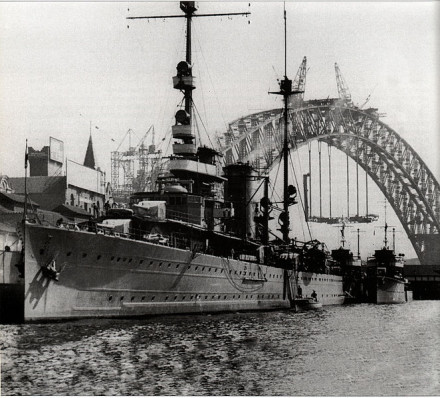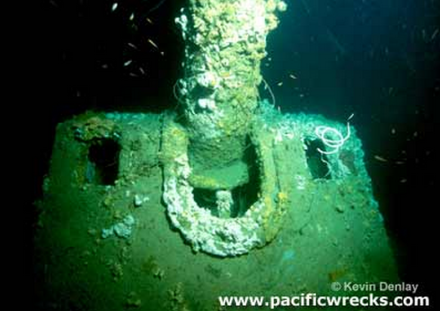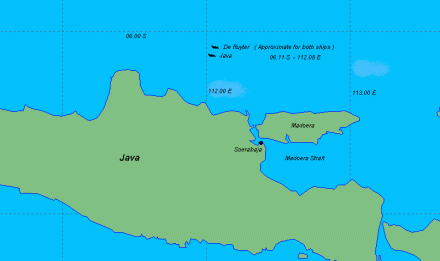History
Construction
In 1916, the keel was laid for the Royal Netherlands Navy light cruiser Hr.Ms. Java at the Koninklijke Maatschappij de Schelde in Vlissingen. The building process faced many delays, due to a lack of supplies, several labour strikes and the nationwide introduction of shorter working hours. After the Java had finally been launched, the ship became damaged during a performance test, and it was not until 1925 that the ship entered service in the former Dutch East Indies.

Battle of the Java Sea
On 27 February 1942, having served as a convoy ship for several years, the Java became involved in the Battle of the Java Sea, which would seal the fate of the Dutch East Indies. While sailing off the Javanese north coast, the American-British-Dutch-Australian (ABDA) Combined Striking Force under Dutch rear admiral Karel Doorman, was surprised by the two Japanese heavy cruisers Nachi and Haguro.
As Doorman's fleet was overpowered by the Japanese, an escape was attempted. However, just around 23:30, the Java was hit by a torpedo fired by the Nachi. The ship sank immediately at the cost of the lives of 491 of its crew members. Another four allied ships (amongst which was the Dutch Hr. Ms. De Ruyter, the flagship of Doorman) were sunk during the battle, which factually eradicated Dutch presence in South-East Asian waters and marked the end of the Dutch colonial age.
A documentary by the NIMH (Dutch Institute for Military History) on the Battle of the Java Sea.
Description
Yard: Koninklijke Maatschappij De Schelde, Flushing, the Netherlands
Armament:
10 x 15 cm guns
8 x 40 mm machine guns
6 x 12,7 mm machine guns
2 x 5 depth charges
2 airplanes
The ship was laid down on May 31st, 1916, launched on August 6th 1921 and commissioned on May 1st 1925.
| Master | Stralen, P.B.M. van |
|---|---|
| People on board | 512 |
| Power | 72000 hp |
| Speed | 31 knots ~ 36 mph (57 km/h) |
| Length | 508 ½ feet (155 m) |
| Width | 52 ½ feet (16 m) |
| Draft | 20 ¼ feet (6.2 m) |
| Displacement | 8210 ton |
Status
Shipwreck
The wreck of the Java is indicated as 'Historic Shipwreck' on official nautical charts. It was was discovered in 2002 using side-scan sonar and diving inspections during an expedition led by Kevin Denlay. The wreck was found lying on her starboard side in remarkable condition.

Salvage
In 2016 it was discovered that the wrecks of the De Ruyter and the Java, and much of the Hr. Ms. Kortenaer had disappeared from the seabed, although their imprints on the ocean floor remained. During a meeting on November, 23 2016, President Widodo of Indonesia and Prime Minister Rutte of the Netherlands agreed that the countries would work together to determine what had happened and to preserve their maritime heritage in the future. A three-tracked approach was agreed upon by both governments:
- Verification of the disappearance;
- Appreciation of what had happened; and
- Future cooperation to manage remaining maritime cultural heritage.
More information on this joint Dutch-Indonesian research can be found in the publications under references and here. It is assumed that the ships have been illegally salvaged because of the iron from their hulls. The iron of this type of ships is very valuable and sought after. It is of an unusual quality since it has been made before nuclear weapons were detonated in the atmosphere from 1945. Because of this, the steel has not been subjected to radioactivity during its production and it has a low background radiation - making it useful for specialist measuring equipment amongst other things.

References
- Report of the Dutch Shipwrecks in the Java Sea.
- M.R. Manders/R.W. de Hoop/S. Adhityatama/W.A. Barten/B. Budi Utomo/O. Dwiyana/A. Kusno/J. Rechar & Z. Tahir (2017).
Joint Verification of the location and condition of Hr.Ms. De Ruyter, Java and Kortenaer. - RCE (2018).
Public Summary Report of the Joint Expert Meeting on the Appreciation (track II) of the Dutch Shipwrecks in the Java Sea. - M.R. Manders & R.W. de Hoop (2018).
Battle of the Java Sea: Past and Present Conflicts. - M.R. Manders, R.W. de Hoop & Shinatria Adhityatama (2019).
Field Assessment Java Sea Survey of three Dutch WWII naval wreck sites in the Java Sea, Progress Report. - S. Lovegrove/R.W. de Hoop/S. Adhityatama (2020).
Good practice: international collaboration on shared difficult heritage.
Sharing Heritage Expertise nr. 13. - M.R. Manders/R.W. de Hoop/S. Adhityatama/D.S. Bismoko/P. Syofiadisna & D. Haryanto (2020).
Battle of the Java Sea: One Event, Multiple Sites, Values and Views.
Journal of Maritime Archaeology 2021. - Hr. Ms. Java.
- The Battle of the Java Sea.
- Rear-admiral Karel Doorman.